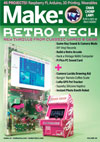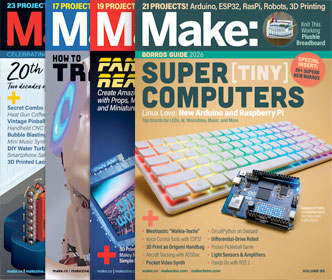
“I want to say one word to you, son – just one word…Plastics.” -The Graduate
The very word means capable of being shaped, molded. Plastic is a cheap, durable, plentiful, extremely adaptable, and variable material that can be put to seemingly endless uses, from product packaging, furnishings, building materials, and machine parts, to tools, weapons, vehicles, to now just about anything that can be extruded from a 3D printing head. The downside of its cheapness and ubiquity (not to mention the polluting nature of its manufacture) is that it leads to a profusion of waste material.
Over the next month here on MAKE, we’ll look at all aspects of understanding and working with plastics: what is is, what the different types are, how to cut, mold, fix, cast, and how to best utilize it in your projects. And, we’ll also talk about creative ways of reusing and upcycling plastic waste materials.
As always we’d love to get your input on the subject. What aspects of plastic would you like to see us explore. Please tell us in the comments.
64 thoughts on “Introducing Plastics Month”
Comments are closed.
ADVERTISEMENT
Join Make: Community Today











I’d love to see more on learning how to determine the specific polymer and what you can do with it. For example, some polymers can be welded very effectively with model airplane glue. Some can’t. I have no idea why. Right now, I dab a little glue on a corner of the material and see if the surface of the plastic softens. If it does, then usually the material will effectively weld… to itself at least. Are there different types of plastic welding glue that work with only certain types of plastic? Do I need special types of paint for certain plastics?
1) where to get sheet plastics at a reasonable price; where to get rods and solid shapes …
2) which plastics can be laser cut and which cannot (I understand that if it contains vinyl then should not be layer cut due to poisonous and/or corrosive fumes
3) easy test to tell if plastic incorporates vinyl
4) is Tyvek a plastic? Can you obtain it without the nasty logo printed everywhere?
I saw sheets of white HDPE 15″x20″x1/2″ being sold as cutting boards at Sam’s Club, a MallWart bulk-sale derivative, for $10.84. Beware though, both sides are textured and theres a company imprint in a corner, other than that they are perfect (ie no holes).
It’s the chlorine in the vinyls that “prevents” the stuff from being lasered.
I saw sheets of white HDPE 15″x20″x1/2″ being sold as cutting boards at Sam’s Club, a MallWart bulk-sale derivative, for $10.84. Beware though, both sides are textured and theres a company imprint in a corner, other than that they are perfect (ie no holes).
It’s the chlorine in the vinyls that “prevents” the stuff from being lasered.
http://www.usplastic.com/ has a pretty wide selection of rod and, well, everything.
http://www.usplastic.com/ has a pretty wide selection of rod and, well, everything.
Small Parts is also a great source for small orders: http://www.smallparts.com/
And for hobby plastics: http://www.plastruct.com/
Plexiglas™ Perspex™ poly(methyl-methacrylate) : cutting/drilling without melting. bending (with some melting), (water-tight) gluing? does that require methylene chloride, or is there something better? can it be effectively tapped? nylon screws? sources for thick sheets and rods?
Good DIY bender. https://sites.google.com/site/mechatronicsguy/acrylic-bender
I just hope this whole experience doesn’t seem plastic. Sorry a pun is a terrible thing.
Maybe we’ll see some non petroleum plastics in the series to come.
I agree! I recently tried to find a DIY techniques for synthesizing bio-plastics out of vegetable oils, but it doesn’t look like the tools or chemicals are readily available. The best I could find is making play-putty from casein (milk proteins) — that is, cheese.
I just hope this whole experience doesn’t seem plastic. Sorry a pun is a terrible thing.
Maybe we’ll see some non petroleum plastics in the series to come.
I’d like to see someone come up with a way to take ABS plastic from old printer cases and the like and turn it into a spool suitable to extrude from a 3D Printer.
You would need to grind them up into sprinkle sized pieces. You would also need a die and extruder. Maybe a good gimmick for a company that makes the spool but not really practical for DIY.
Make sure you cover composite plastics like carbon fiber and fiberglass. I’m pretty sure they still count as plastics. Also cover some plastics used in 3D printing. Maybe cover PLA which is a bioplastic made from corn. Its a very popular material to print with on a Makerbot. Also cover some different synthetic fibers, like nylon, kevlar (or other aramids), and polyester.
Make sure you cover composite plastics like carbon fiber and fiberglass. I’m pretty sure they still count as plastics. Also cover some plastics used in 3D printing. Maybe cover PLA which is a bioplastic made from corn. Its a very popular material to print with on a Makerbot. Also cover some different synthetic fibers, like nylon, kevlar (or other aramids), and polyester.
Composites like carbon fiber and fiberglass don’t count as plastics by definition: plastics are composed of chains organic polymers, whereas composites are sheets of typically non-organic fibers embedded into a plastic resin (i.e. it’s a composite material of plastic and some reinforcement). However, I agree it’s still relevant to plastics-forming in general; and, like PLA, totally relevant to Plastics Month. :-D
I would like to see how to use a hot air gun with a plastic welding nozzle. The type where you manually feed a (colored) rod at the back of the nozzle. Like this http://lib.store.yahoo.net/lib/engineeringlab/plastic-weld.jpg stuck on top of this http://lib.store.yahoo.net/lib/engineeringlab/9mm-reduction.jpg.
And as mentioned before, how to determine what different types og plastic are like, since they’re not always marked
Information on various techniques to work plastics would be helpful. Especially where there are homebrew methods that can substitute industrial methods. (a common example: vacuum forming)
I’ll echo the request for information on identification and sourcing too.
Information on various techniques to work plastics would be helpful. Especially where there are homebrew methods that can substitute industrial methods. (a common example: vacuum forming)
I’ll echo the request for information on identification and sourcing too.
Hi folks, I’m a long time reader (~ 2 years), but this is my first time posting. I studied plastics engineering in college and currently work for an injection molding company. Would be happy to help answer or discuss some of the technical questions about plastics!
To the benefit of the Maker Community I would hope this month covers:
– Ways to identify and safely re-use plastics at home
– Notable differences between types of plastics (properties, best machining/forming/joining methods per plastic)
John: Can you contact me? gareth at makezine com
Someone had mentioned plastics identification. Polymer Engineer to the rescue! Here is something we used in college. http://www.consultekusa.com/pdf/Tech%20Resources/New%20ID%20chart%20.pdf
It’s down and dirty, far from the accuracy of a differential scanning calorimeter, but it works!
I would like to see some recycle projects. I wish you had sent out a call for writers. I do a lot of stuff with soda bottle plastic and would love to contribute to this. Been a fan of this website and craftzine for a long time.
I would like to see some recycle projects. I wish you had sent out a call for writers. I do a lot of stuff with soda bottle plastic and would love to contribute to this. Been a fan of this website and craftzine for a long time.
We would love to see your work with soda bottles, Mamabear. Please send to me: gareth at makezine with a dot and a com.
We would love to see your work with soda bottles, Mamabear. Please send to me: gareth at makezine with a dot and a com.
I would like to communicate with you about forming with recycled plastics – I am an art teacher in Alaska and we are working with marine debris and want to reuse the plastics as materials for art – specifically vacuum forming.
email me @ bonnie_dillard@yahoo.com
These are all great ideas, folks. Thanks so much. Keep ’em coming. And thanks to those sharing resources. Keep those coming as well.
We will definitely be covering recycled plastic projects and want to put together a guide to different types of plastics, their characteristics, uses, etc. And we’ll be covering composites.
I’d love to see how people are using newer bio-plastics. I’ve seen people using PLA with some success; I’ve often wondered if Greensulate, a mushroom-based insulation foam, can be carved in a similar way to Styrofoam. Any sort of DIY plastic making would be awesome too, beyond milk plastics.
I’d love to see how people are using newer bio-plastics. I’ve seen people using PLA with some success; I’ve often wondered if Greensulate, a mushroom-based insulation foam, can be carved in a similar way to Styrofoam. Any sort of DIY plastic making would be awesome too, beyond milk plastics.
A guide explaining how to fix broken plastic parts, from static (such as a corner of a remote) to those that need to stay together against a force (such as a handle)
How to choose repair material? How to secure in place? Paint and polish?
Keep in mind that many plastic pieces are not sold individually to it’s either fixing or trashing